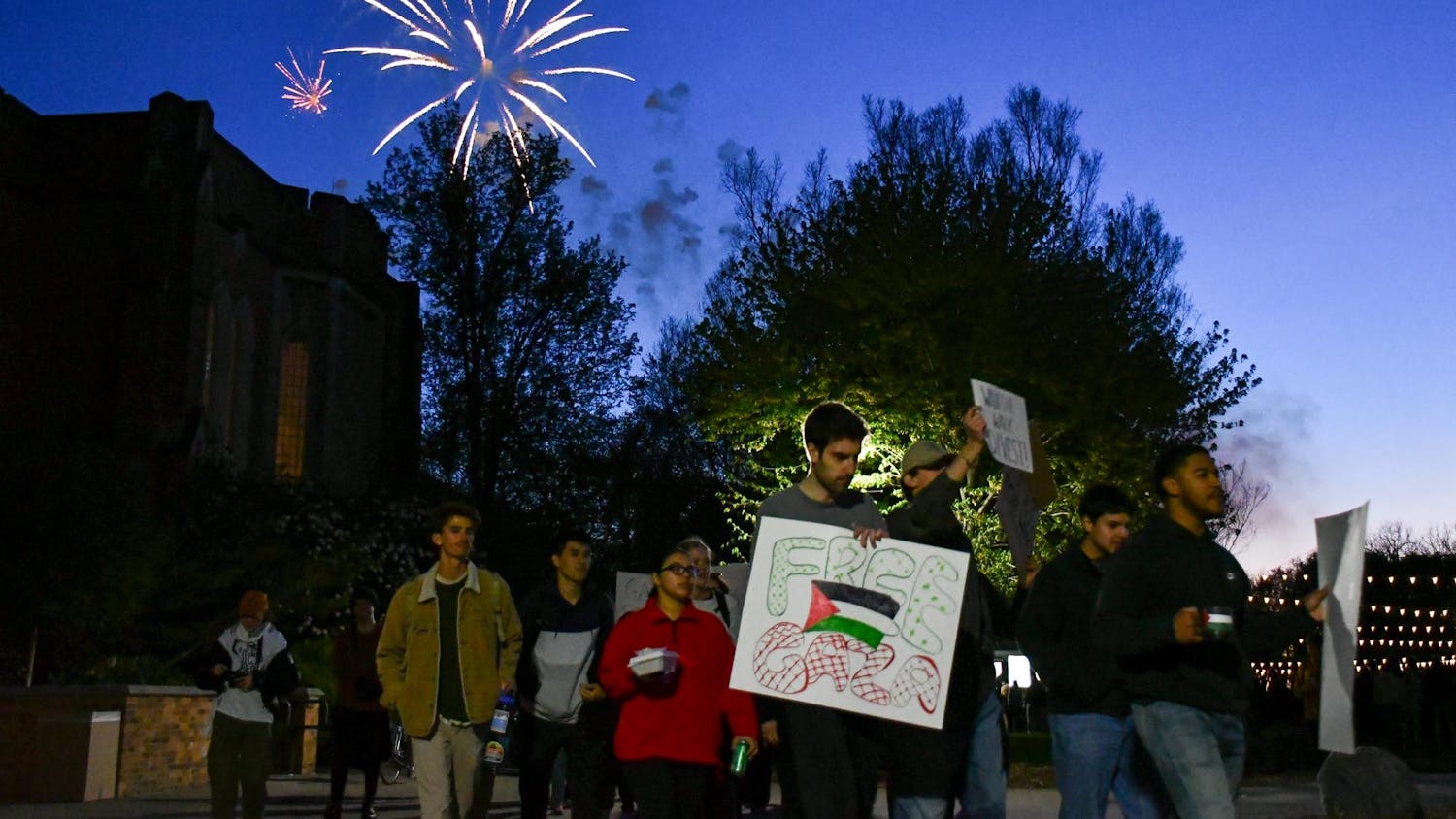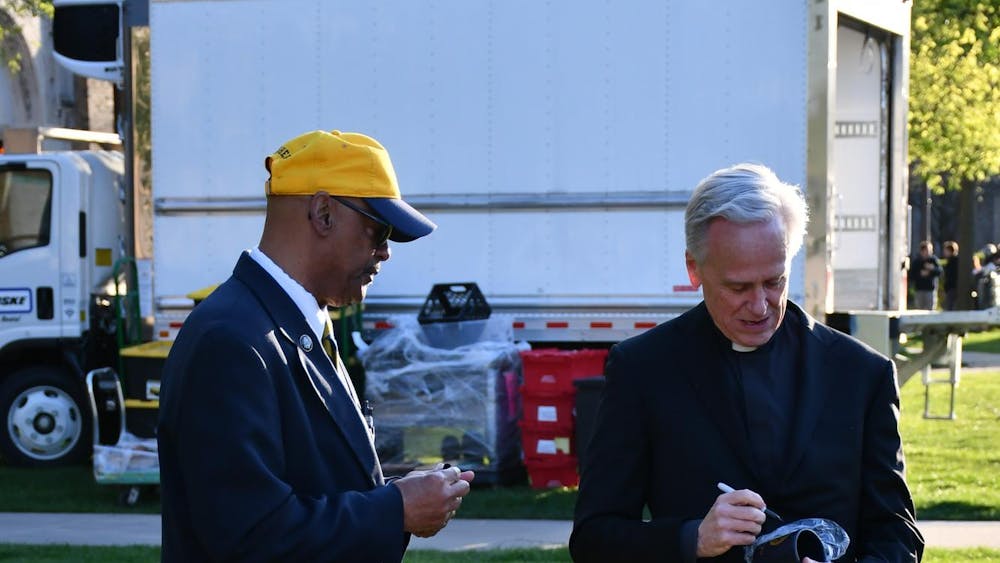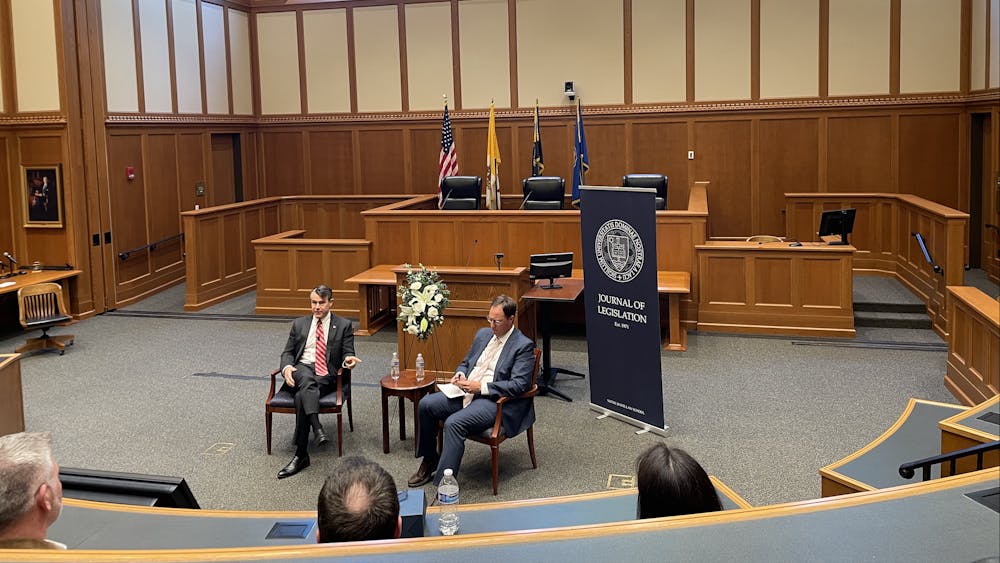Editor’s Note: This is the second story in a two-part series examining the ways Native language and cultural identity are being kept alive by the students of Notre Dame.
For many Notre Dame students, the city of South Bend is simply known as the area surrounding the University. But, the general region of South Bend is also known as Zenba Odan — or “Ribbon Town” — to the Pokagon Band of Potawatomi.
This past spring, a land acknowledgment resolution was passed by the student senate, largely prompted by the Native American Students Association of Notre Dame (NASAND), yet the University still does not formally acknowledge the tribe’s major role in Notre Dame’s founding.
The land acknowledgment resolution was proposed to be read at all major Notre Dame events in order to recognize the Potawatomi land the University sits on. Marcus Winchester, the director of the language and culture department of the Pokagon Band,said many people who are affiliated with the University do not realize that the Potawatomi invited Fr. Stephen Badin to the area that is now Notre Dame.
“I think it would be a huge milestone if the University would acknowledge that we’re the ones that welcomed Fr. Badin and requested his presence,” Winchester said. “And then when Fr. Badin left, Fr. Sorin was the one who came in and replaced him. So you know, that institution wouldn’t be there if Leopold [Pokagon] had requested someone else.”
The Pokagon Natives have been in this area longer than Notre Dame itself, and have a history in the area dating back to the 1830s, years before Notre Dame was initially settled.
Blaire Topash-Caldwell, an archivist for the Pokagon Band, said in an email that the 1830s were a stressful time for tribes in the Great Lakes region.
“Many villages were cut off from trade, left out of major policy decisions and forcibly removed from their home lands to foreign environments [in the] West,” Topash-Caldwell said. “Many native people died en route or starved once they reached their reservations. During this time, Leopold Pokagon was very politically active in treaty negotiations and forging important political relationships in order to protect his people.”
In July of 1830, Leopold Pokagon journeyed from southeast Michigan to Detroit to ask Fr. Gabriel Richard to send a Catholic priest to oversee the failing Carey Mission in Niles, Michigan.
But, Issac McCoy, the pastor of the failing mission, refused to allow Leopold and newcomer Badin to succeed the Mission in Niles. So, they decided to start a brand new mission in one of Leopold’s villages — this village was in present-day South Bend.
A year later, Badin built a chapel and the mission was thriving, Topash-Caldwell said.
“In 1834, Fr. Badin donated over 500 acres of this land to the Diocese of Vincennes, and in 1842 this land was given to Fr. Badin’s successor under a condition that a college would be built there. That successor was Fr. Sorin and that college is Notre Dame,” he said.
Winchester said Native Americans in the area often tried to negotiate with Americans instead of fighting or resisting. This approach would eventually lead to the creation of Notre Dame.
“The United States wanted Potawatomi land, and they would go into these treaties with our leaders,” Winchester said. “What our leaders did, rather than try to fight or resist the Americans, was decide that we would try to have influence over American expansion rather than resist it. So, one of the ways that they did that was in treaty negotiations with the United States government. They would request things like log cabins, livestock and they also requested a missionary.”
This missionary became the failed mission in Niles that ultimately led to the creation of a brand new mission in South Bend. However, the Treaty of Chicago in 1833 by the U.S. government aimed to give the Pokagon’s land away to Americans.
“When Leopold went to the Treaty of Chicago in 1833, he discovered that treaty was intended to sign away the last of the Potawatomi land in Michigan and Indiana,” Winchester said. “Leopold used the successful mission that he had established with Fr. Badin as a justification for why our group of Potawatomi shouldn’t be moved out west. The United States government agreed that it was a very successful mission, and there was no need for us to be removed. Fr. Badin left, and had a few replacements come in, but his long-term replacement was Fr. Sorin.”
From then on, Winchester said Notre Dame and the Pokagon maintained fairly good relations — that is, until the 1990s.
“There’s always been a pretty respectful relationship between the tribe and Notre Dame,” Winchester said. “A long time ago, anytime any of our families needed anything, we could go to the school and they would help us out — whether it was food or clothing, or whatever it might have been. … I think relationships kind of went sour in the ’90s because there were some Potawatomi particular — that Hannahville Potawatomi from up North and Upper Peninsula, Michigan — tried to bring a lawsuit against the institution about land claims, so that kind of soured things.”
As for the present day, Notre Dame professors will often host Potawatomi leaders in order to ensure students become more educated on the tribe’s history in the area.
However, aside from this and the land acknowledgment, Native American students don’t have many resources or support on campus, Marcus Winchester-Jones, a Pokagon student and the current treasurer of NASAND, said. Winchester-Jones was the president of NASAND for the 2018-2019 school year, and the group, made up of many of the Native students on campus, has advocated for the removal of the Columbus murals, a land acknowledgment, a Native Studies major and even more resources for Native students.
“I would like to see more support, and maybe some native traditions on campus,” Winchester-Jones, a junior and the cousin of Marcus Winchester, said. “I know, back in the day, there was a powwow celebration that they did on campus. We could start to bring that back with the help of administration. I think that it would be huge, just because this was native land back in the day. … It could be better to help develop and strengthen those bonds.”
In an effort to maintain the use of the native language of the Potawatomi people, Neshnabémowen, the Tribal Historic Preservation Office employs fluent speakers that have launched an online dictionary. The tribe also has several initiatives in place to keep the culture and language alive.
“We also have a Cultural Activities Coordinator who’s organizing regalia-making classes, sugar bush camp and several other programs,” Topah-Caldwell said. “We have two team members who work with youth — everything from after-school programs, culture camp, and mentoring the Youth Council.”
Although the tribe is based in Dowagiac, Michigan — about 45 minutes north of Notre Dame — the presence of the tribe can be seen in South Bend, from the street names and businesses to the Four Winds field.
“Obviously, we have the casino on the southwest side of town, and we also have the Four Winds Fields. But that doesn’t belong to us, you pretty much pay to have your name on that with a contract,” Winchester said.
Winchester-Jones said he would also like to see more Native Americans on campus, but it is difficult to persuade native communities to send their children to Notre Dame.
“I would like to see more natives on campus,” he said. “It’s tough to get people to come to where there’s not a lot of people like them. But if there’s more effort shown and more effort communicated to those that are already on campus that they’re trying, that would be very, very nice to hear. Because I don't hear much of it.”













